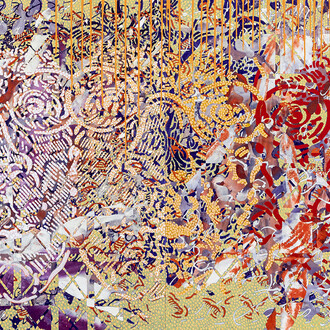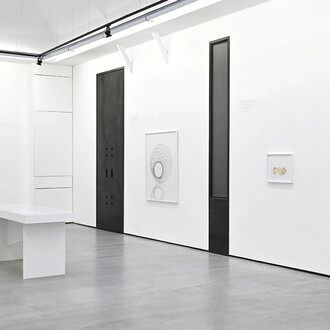A Personal Sonic Geology gathers together the films realised by Mathieu Copeland and Philippe Decrauzat since 2012. Stemming from a desire to film sound, record places, and dive into the process of a material construction and destruction, these films are screened using a projection apparatus that integrates an exhibition of monochrome screens/paintings.
Invited to create a programme and events and exhibitions at le Plateau from march 2014 on, Mathieu Copeland and Philippe Decrauzat have each time used these spaces and this time to involve artists from the visual and music fields—using the exhibition format, or he denser format of the event—and film, their end purpose being to pursue their film collaboration to present to the eye and ear, in the form of an immersive arrangement, something that has already been seen, heard and experienced.
Creating a dialogue between filmed images, painting and sound production, these films bring together a constellation of artists, superimposing and fragmentating the 16 mm film stock. Filming musicians including Alan Licht, Ellen Fullman or FM Einheit as they realise the soundtrack for these films to be, creating a dialogue between works of art and the camera, with Marcia Hafif’s drawings or a painting by Peter Halley, filming moments and places of creation such as the realisation of a painting by John M Armleder, the re-enactment of a lecture-demonstration by Gustav Metzger, Swiss artist and “researcher” Emma Kunz’s Grotto, and production sites including a printing press in Marrakech, a textile manufacture or a paint factory, the film’s components shape a linear assemblage of overlaid realities.
This programme has been the subject of a series of manifestos drawn up guests artists, lending each exhibition and event its title and thus connecting all the elements of the project, like links in one and the same huge enselmbe, offering us a re-reading of a history of modernity seen through visual arts and music.
Films already made:
Alan Licht/The regional press
Shot in a the New York loft of the minimalist composer Phil Niblock, the American guitarist is filmed at the very moment when he improvises and produces the film’s soundtrack. Distorted and distended acoustic landscapes which encounter, in superimposition, the mechanical and anachronistic outbursts of a Heidelberg typographical press loaded with white paper and running idle.
This other side of the film was filmed in the regional press printing works, in Marrakech, the very place which prints the “manifestos” that can be found at Le Plateau, handed out during the exhibitions and events programmed by Mathieu Copeland and Philippe Decrauzat, and which thus tally with the visuals organized throughout the cycle.
Ulrich Krieger/Textile spinning
The composer and saxophonist Ulrich Krieger is filmed in the sound studio at Calarts University, where he has been teaching since 2007. For the film’s soundtrack, he performs one of his compositions titled Raw-Desert Towns of Southern California. A very physical drift with sombre and apocalyptic sound coloration which is overlaid on views of spinning and weaving cotton fabrics taken in a factory in northeast Germany, which is also the production site of the fabrics used for making the black monochromes on which these films were projected in previous shows.
F.M Einheit/Atlas
Shot on the border between Austria and Germany, in the High Atlas mountains of Morocco, and in the Sahara, this film presents the German musician and percissionist F.M. Einheit (formerly Einstürzende Neubauten—a pivotal group in the post-punk industrial music created in Berlin in 1980) at work at home, in his garage, destroying bricks and mirrors, playing with the sound of stones and sand on a large amplified sheet of metal. F.M. Einheit composes and creates an architecture of abstract and temporary ruins, which is overlaid on undulating views of Saharan and Atlas landscapes, echoing that Einstürzende Neubauten concert given in the Mojave desert on a day in 1984, where, having arrived empty-handed, F.M. decided to use what he found on the spot, pebbles, sand, bits of bricks, as percussion elements, a ground-breaking moment in his sound work.
Parking lot Mexico
A three-part film, in black and white and colour, based on the re-creation of the Gustav Metzger’s lecture-demonstration, South bank Demonstration, released in London in 1961, when he sprayed acid over a succession of three re, white and black nylon canvases. In twenty minutes or so, the work of art was created by self-destructing.
In 2013, this supremely iconoclastic gesture was re-constructed with the agreement of Gustav Metzger in the parking lot of the university and contemporary museum in Mexico City. A succession of filters merge together and are unravelled. Gnawed grids which let elements of the “décor” appear. A landscape which adds to itself in a ballet with a soundtrack by the musician Robert Poss who, for the occasion, recorded a barely audible analogical silence which becomes white noise.



















